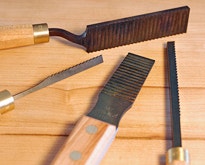What's the Difference Between Rasps and Floats?
What's the difference between floats and rasps, other than the tooth patterns? When is it better to use floats, and when is it better to use rasps? And if I can only buy one, which is the more versatile and useful overall? - Chris Hodgkin
Chris Marshall: A rasp is covered with patterns of either regularly spaced and patterned (machine-made) or irregularly spaced (handmade) teeth. The teeth on a rasp are formed into the metal through a process called stitching. When a rasp is handmade, stitching involves punching a hardened chisel into the body of the rasp to raise the curved-edge teeth. It's sort of like peeling a banana, and the speed with which a skilled rasp maker can do it is astonishing.
Instead of having a rasp's individual teeth, a float has longer, straight teeth cut in uniform rows across the face of the tool or into its sides. The teeth on a float can be re-sharpened by the end user with a file, unlike rasps, which can't be resharpened. Floats purportedly can cut more aggressively than rasps, but still leave a smooth finish. They work on both flat and broad, convex surfaces for stock removal and smoothing. They are also often used to sneak into narrow openings, such as mortises, as well as for refining the interiors of wooden plane bodies. Floats have flat faces.
The cutting quality of rasps will depend to some degree on how the tool is made. Machine-made teeth tend to leave a coarser surface because of the uniformity of the tooth pattern. Hand-stitched teeth generally leave a smoother cut if the tooth pattern varies, so one row of teeth cleans up waste left by the row in front of it instead of just following behind in the same tooth tracks. Rasps have a curved face and a flat face, so they can refine both concave and convex shapes large or small as well as flat surfaces.
Which tool type will work best for you - floats or rasps - will depend a lot on what the shape of the surfaces are that you need to smooth, how often you will use the tool, whether or not you want to be able to resharpen it and how much you are willing to spend - handmade costs more than machine-made, not surprisingly.
Tim Inman: Well, let's take these in order. Other than tooth patterns, each tool has been designed for a specific purpose. When is it better to use floats vs. rasps? Floats are designed to virtually "plane" off very delicate amounts of wood over large face-grain surfaces. They are commonly the tool used by plane makers to dial in the wood for the plane. Rasps are general purpose cutters which cut end grain about as well as face grain. They are the workhorse of the two tools. A rasp will take off big amounts of material from virtually any angle or surface. Putting a new handle in a shovel, or roughing in a carving would both be first choice jobs for a rasp. Flattening a sole plate on a hand plane would be the job for the float. If you can only buy one, then the answer is easy: buy a rasp. It is not only more available and hugely cheaper, it will be the one you'll use more often. I have several sizes of a handy rasp in my shop. They're cheap and available almost anywhere files and rasps are sold. They are called 4-in-hand. They have two different cutting coarsenesses and two different shapes on each tool: fine flat, fine semi-round; coarse flat, and coarse semi-round. I use my 8-inch 4-in-hand most often. I have a 10-incher and a 12-incher, too. I actually don't have a float - never have needed one. Plus, they are really expensive!
Keep the inspiration coming!
Subscribe to our newsletter for more woodworking tips and tricks





